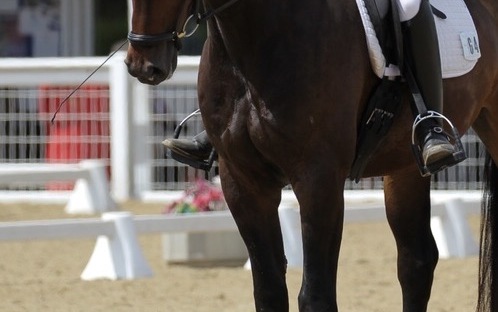It’s been nearly a week since we ventured out to do our first Novice tests last weekend – I’m not sure where the time has gone! Here’s a quick run through of how it went:
I had a very civilised start time, so I was quite organised for once and arrived with plenty of time to spare. It was a very hot day but I wanted to give Rupert enough time to settle, so he would be nice and relaxed for the tests. But in the boiling hot indoor arena, it felt like we were warming up for ages and Rupert started to feel like he was flagging.
Eventually we were called for our test. I did a little dance inside when he walked through the barriers and past the giant champagne bottles, bins and other ringside gremlins which have been an issue in the past. But I wasn’t prepared for the new monsters which had suddenly appeared in the form of FLOWERS which were neatly dotted around the arenas. Because there is very little room around the edge at Keysoe, we spent a very embarrassing few minutes (seemed like hours) reversing into white boards and demolishing the arena as I tried to persuade Rupert that the horse-eating blooms were nothing to worry about!
Eventually, with a change of direction, some swift repairs to the arena, and a huge pony club kick, we somehow made it down the centre line. But his mind was not on me at all and he spooked his way around the test. If swerving were a real movement, we’d have got 10s!
In the lead up to this outing, my main worry was how difficult the second test was. I soon forgot about that as I was faced with a much more basic problem of actually getting in the arena and going anywhere near the outside track! I wasn’t really looking forward to going back in and Rupert felt very flat in the warm up. But I was relieved when a kind lady agreed to read the test for me, as it was one less thing to worry about if we had navigation problems!
Surprisingly, Rupert was a lot braver about the flowers this time. They were still terrifying but we had more space to get round them in the second arena, so he didn’t panic. The test felt 100 times better than the first, still spooky and behind my leg but I was absolutely delighted with the improvement. I did ask for medium trot and canter but there wasn’t much gas left in the tank by then, so the marks reflected that. I didn’t dare let go for long in the give and retake the reins, as the flower pots were looming up ahead, but the counter canter was easier in the big arena than at home.
All in all, I felt it was a massive learning experience for us both. I warmed him up for too long because, although he was nice and relaxed in the warm up, that all went to pot (literally) when we went to the test arena. He was then behind my leg and not really listening. I was pleased with how Rupert improved for the second test, as he started to accept my reassurance that the flowers were not out to get him – something to practise at home I feel.
The first test was a bit of a disaster but the judge’s comments were really supportive and encouraging, particularly on how I had ‘coped with the situation’! The second test was better for 62.8% but I felt a little disappointed with the marks and comments. I guess, to me the difference between the two tests was so immense I was expecting an award for actually doing a 20m circle! But it was a different judge and they have to mark what they see in front of them – there are no prizes for lack of swerving. I felt a little better seeing other people having similar issues getting into the arenas and riders exchanging supportive tales of woe – it meant we weren’t the only ones overreacting to the decorations!
With a qualifying score for the Petplan Area Festivals, I have been debating whether to rush out again in the next few weeks to try and get another two sheets before the deadline. But I’ve decided to take the pressure off a bit. It’s not so much the qualifying, but the Area Festival is the week after the Regionals and my husband will be away for both – making it more tricky with home, the kids, work and everything else. So, I’m just going to focus on the Regionals for now and plan ahead a bit more for our next Novice outings. Sometimes you have to think about the bigger picture, and I never even dreamed we would qualify for anything this summer. I’m delighted that we’ve come such a long way since our first competition back in April and thankful that all the things I worried about then, are not as much of an issue now. Onwards and upwards as they say…..








